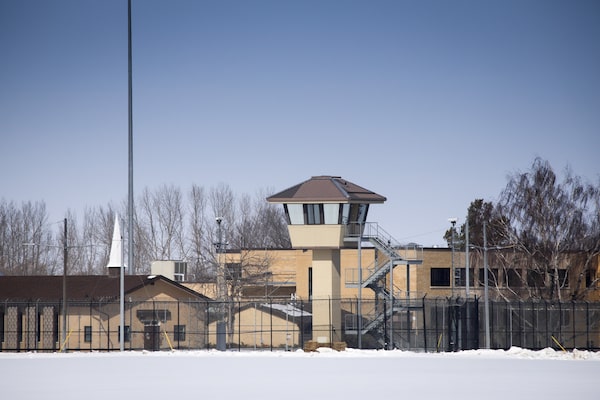
The Bowden Institution medium security facility near Bowden, Alta., Thursday, March 19, 2020. Government medical professionals say Canada's jails and prisons don't meet with physical distancing guidelines for COVID-19 and they want as many inmates as possible to be released.Jeff McIntosh/The Canadian Press
Justin Ling is a Toronto-based freelance journalist.
Whenever this pandemic abates, it will take some time for us to fully grasp COVID-19′s ravages. No population has been harder hit than our seniors; the extent of the loss in Canada’s long-term care homes underscores how desperately we need to address the negligence in those facilities. Unfortunately, we’ve also seen other ill-prepared institutions hit hard by this virus. In prisons across the country, outbreaks have led to more than 350 federal inmates testing positive for the virus; two have died.
But there are people who are, hideously, experiencing both of these nightmares at once. Hundreds of elders are currently in federal prisons, sitting in isolation, with scant access to health care and acutely at risk of dying from COVID-19.
Our correctional institutions have become warehouses for aging prisoners, some of whom have long been rehabilitated. Their continued incarceration is a logistical nightmare and a massive financial burden, and now, it is putting their lives at risk.
A quarter of federal inmates are older than 50. Roughly 700 of those are 65 and older, and of those, more than half have hypertension. Dozens have had a stroke, or are suffering from dementia or Parkinson’s disease.
It’s a problem decades in the making. “Prisons were never intended to be nursing homes, hospices, or long-term care facilities. Yet increasingly in Canada, they are being required to fulfill those functions,” reads a joint February, 2019 investigation from Dr. Ivan Zinger, the correctional investigator of Canada, and Marie-Claude Landry, who heads the Canadian Human Rights Commission. It found that those institutions often lack basic health care, let alone palliative or specialized services.
This a demographic trend. A 2011 report from Dr. Zinger’s office warned that life and indeterminate sentences, as well as the increasing prevalence of mandatory minimum sentences, are driving this graying of our prisons.
Rather than acknowledge this as a problem of Ottawa’s making, Public Safety Minister Bill Blair explained away the death of one inmate from COVID-19 on a Facebook livestream with a fellow Liberal caucus-mate by saying he “was an individual in his 70s, and had some other health concerns.”
Following Dr. Zinger’s recommendation – to assess every inmate over the age of 65 for release – will be hard to accept for some, and understandably so. Releasing a convicted killer, even if they are in their 70s, will be untenable for many, not least of whom the victim’s families. And certainly, serial killers and sexual predators who still pose a risk to the public cannot be released.
But many federal inmates have been eligible for parole for years and, for whatever reason, have yet to be released. This, despite data that suggests that parolees older than 50 are the least likely to re-offend, and that only about half the inmates over 50 are serving life sentences. In some cases, Ottawa has simply failed to build the capacity needed to get older prisoners out, with some inmates who have been granted parole waiting years to finally be released due to lack of accessible halfway houses.
Take the case of Fallon Aubee. She was convicted for first-degree murder in a 2003 gang-related slaying. Ms. Aubee spent years calling for changes to how transgender inmates are treated in Canadian prisons and, after winning that fight, now works as a prisoner advocate. She is in her 60s, and is also suffering from a number of medical conditions that make her high-risk for COVID-19. “I have a wife and a community,” Ms. Aubee told me in April. “We have a home.” She seems to be an ideal candidate for parole. Despite applying, she remains incarcerated.
The Parole Board of Canada has the power to grant parole in exceptional cases, such as in health emergencies. Over the first two months of the pandemic, just four were granted.
Our prison system needs to operate on the premise that incarceration balances deterrence, the possibility of rehabilitation, public safety and proportionality. This system was not designed to lock people up until they die: That is just the death penalty, by another name.
But the Trudeau government has demurred on Dr. Zinger’s call to action. Mr. Blair’s office has said it is working on a “comprehensive needs assessment of the CSC’s older inmate population.” (“This is not what I recommended,” Dr. Zinger told me recently.)
Things are tense inside Canada’s prisons. Staff are walking into a powder keg every morning, and need to serve double-duty as long-term care workers. Many inmates are locked in their cells 23 hours a day. Medical services have been suspended and crucial medication is in short supply. We need to stop making things worse.
Sign up for the Coronavirus Update newsletter to read the day’s essential coronavirus news, features and explainers written by Globe reporters and editors.